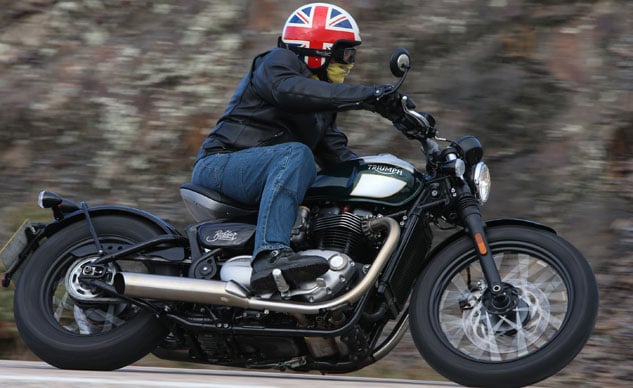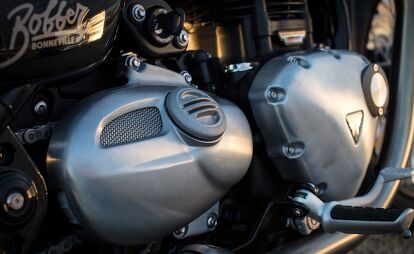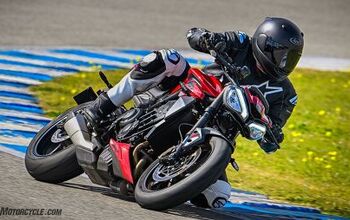2017 Triumph Bonneville Bobber First Ride Review
Triumph gets back to basics with a thoroughly 21st-century bobber
By now you must’ve heard the bobber backstory: Restless GIs home from WW2 self-treated their PTSD by bobbing the fenders off their heavy old motorcycles to make them lighter, faster and generally more obnoxious to the populace. Triumph was right there from the beginning, supplying Marlon Brando’s bike in The Wild One, and now it’s back with the brand-new 2017 Bobber, the stripped-down, elemental variation on the new Bonneville theme the company’s been furiously rolling out for about a year now.
2017 Triumph Bonneville Bobber
| Engine | 17.5/20 |
| Suspension/Handling | 12.5/15 |
| Transmission/Clutch | 8.5/10 |
| Brakes | 8.0/10 |
| Instruments/Controls | 4.5/5 |
| Ergonomics/Comfort | 8.75/10 |
| Appearance/Quality | 9.25/10 |
| Desirability | 8.75/10 |
| Value | 8.5/10 |
| Overall Score | 86.25/100 |
Unlike all the other dual-shock Bonnes, the Bobber gets a distinctive hardtail-looking frame that actually has 76mm (3 inches) of rear-wheel travel controlled by a single shock under the solo seat – and a solo seat is all it’ll ever be. There aren’t any optional passenger seats in the catalog (though there are more than 150 other things), since the rear fender’s going to be moving up and down with the wheel. Given that there will never be a 150-pound passenger added onto the rear of the bike, the rear shock doesn’t even have preload adjustment; Chief Engineer Stuart Wood says it just isn’t necessary and in fact there are no suspension adjustments (though a Fox shock with adjustable rebound is an available accessory).
He could be right. Triumph says its authentic pure minimalist Bobber also had to make no compromises in the comfort department, and after a day bobbing around the outskirts of Madrid on it, I didn’t hear any complaints from myself or anybody else: Those three inches of travel out back do an excellent job smoothing out rough pavement, and so does the 90mm in front controlled by the 41mm fork, complete with gaiters.
From the looks of the Bobber and its mission statement, I was kind of expecting a bit more of a raw-boned ride, but like every new Triumph we’ve ridden lately, this one has zero rough edges. The temperature the day we rode the bike never got above 48 degrees or so, so it was nice all our bikes were outfitted with optional heated grips. Another available option on this fully ride-by-wire Bobber is cruise control. This authentic historic relic is fully up to date; ABS is also standard, along with traction control and Rain and Road ride modes.
To me, this one says dragracer more than roadracer, but again the Bobber surprises with better-than-expected backroad chops. In addition to cold on our ride day, the road was also patchy damp, but the Bobber was perfectly capable of dealing with the curvy sections of road that were dry. With only 88mm of trail, via 25.8 degrees rake, the Bobber steers light, quick and reassuringly in spite of its stubby flat handlebar. Custom tires from Avon, a 19-inch bias-ply front and a 16-in radial rear Cobra, seem well-matched to the bike and its suspension. (They contain inner tubes.)
It’s not an overly firm ride at all, but a well-controlled one. The only limiting factor is cornering clearance; once you learn to ignore the peg feelers, the exhausts on both sides will drag when you get to about 8 on the backroad aggression scale, and then it’s time to be careful. Usually, we would dial in a bit more preload to keep the rear of the bike riding higher. Not an option here.
Buy hey! Dragging pipes is largely a motojournalistic complaint that’s never hurt Harley-Davidson’s sales of Sportsters, so we’ll give the Bobber a break – especially since the Bobber leans way further than H-D’s worst offenders. Triumph says the seat is 27.2 inches from the pavement in its low position, and an inch higher in the high forward one. For 5-foot-8 me in the high forward position, it’s still a little bit of a reach to the handlebar; I’d find a way to scoot the seat forward another inch. There’s room. My taller compadres, on the contrary, seemed to all really like the Bobber ergos; it didn’t fold them up like some bikes in this class do. (Triumph says the Bobber is in a class of one, but when pressed they say H-D 48, Yamaha Bolt, Indian Scout might be its competitors.)
The seat itself is a very nice piece of engineering, an excellent foam layer cake on a molded aluminum tray that nicely cosseted every butt on the ride I surveyed. Jeff Holt, our friend from Hot Bike, seemed to be in shock: “This is the first time I’ve ridden motorcycles all day and my ass doesn’t hurt.”
Your wrists don’t get much of a workout either; the torque-assist clutch is very low-effort. The like-buttah gearbox didn’t miss a shift all day, and the single 310mm front disc brake works fine also, even if it’s not quite as powerful as the dual discs Triumph puts on the other 1200s. It is a dual-disc setup when you remember to mash the rear brake along with the front, which is easy enough to do since ABS won’t let you lock it up like in the bad old days. One disc is a style thing here, and there is enough power to snap the ABS to attention with two fingers. Still on a bike with so many nice components, the slide-type two-piston front caliper does look a tad déclassé.
Anyway, if the chassis had any faults you’d be tempted to forgive them once you twist the (also low-effort) throttle; a new airbox, located right under the seat, and those shorter dual exhausts let the engineers massage the 1200 HT (high torque) engine from the T120 Bonneville into a new “Bobber tune”, which is claimed to produce even more torque down low. All the internal engine hard parts are the same, but revised ignition and fuelling aid the bump in lower-rpm power. Triumph says the Bobber’s making 10% more torque and power than the T120 at 4500 rpm, and maxes out with 77 hp at 6100 rpm (as opposed to the T120’s claimed 80 at 6550). A soft limiter begins kicking in at 6800 rpm, and it’s no mas at 7k. In normal use, you’ll never rev the torque-rich Twin that high. There is a little abruptness rolling the power back on at about 3000 rpm sometimes, but I don’t think it’s enough to register a legitimate complaint.
All that Bobber tune stuff aids in the “hot rod attitude,” too; you really are marinated in your own sound waves on this bike, just enough to be a minor jerk without having everybody on your street hate you.
It’s also a Euro 4 engine, which Triumph says got 57 mpg on our own EPA test, which is amazing and believable since we got nearly as much with Triumph’s Street Twin earlier this year. Excellent fuel mileage is a requirement, since the tank only holds 2.4 gallons of fuel.
2016 Retro Roadster Gaiternational Shootout
Used for transportation, the Bobber is, again, better than its retro look would lead you to believe. At 80 mph on the Spanish motorway, the engine’s turning over at half its peak revs, 3400 rpm (you can scroll to a digital tachometer), and it’s calm and smooth enough that you’re glad cruise control is an option. The wind nicely offset the weight on my limp wrists at that speed, the bike’s perfectly stable even with its steep geometry, and from there, quick blasts up to 100 mph have the Bobber barely breaking a sweat. Stuart Wood says there is no speed governor. You could go places on the Bobber, quickly and alone…
In town, it’s hard not to treat all of Madrid’s traffic roundabouts as chicanes, lining the Bobber up and shooting out of them in second gear, with a one-finger clutch fan, on another wave of that 270-degree crankshaft racket. You’d think we’d outgrow it. Overall, it’s a thin motorcycle that would make a great L.A. lanesplitter.
As functional as it is, you get the impression this one’s really about the looks. Stuart the Engineer gets a little misty describing the places the designers found inspiration, stretching back to the original Speed Twin of 1938, which had a hardtail frame and that distinctive rear fender stay. The rear hub mimics a drum brake, the shape of that gas tank, the single round headlight…
At $11,990 in Jet Black, it’s not an an inexpensive motorcycle, but it’s a really nicely finished one given that price and its performance. The thing bristles with satin-finished aluminum, bronze-looking plaques and details. Both fenders are real steel, and in fact beyond the airbox and sidecovers, there’s no plastic to be found. Triumph’s also proud of how well-concealed the modern bike is hidden within this one: the radiator’s inconspicuous and the rest of the cooling system’s almost invisible. You’ll have to crawl under to see that the dual headers actually feed a “cat box” under the sump before diverging again into the dual mufflers. There’s ABS, TC, heated grips, but there’s nary a stray wire connector in sight.
It’s historically reassuring in the Trump era and more than a little ironic to see Triumph turn out motorcycles like this one, that out-Honda Honda almost half a century after the CB750 put the English OEM out of business. And it’s more than a little concerning to suffer through a four-hour delay in Atlanta while they try to fix an electrical problem on my Boeing 767, en route to riding an English motorcycle on which all the gremlins seem to be banished: “Ladies and gentlemen, we changed the battery and charger, and that didn’t fix our problem. So now we’re going to try swapping out some relays… we’ll let you know as soon as we know…” Oh man. Who knew they fix airplanes the way I fix cars?
Triumph says its worldwide sales are up 30% since it introduced the Street Twin last year, and that deposits for the Bobber are running twice the number they were on the very popular Thruxtons. If you need one, and I would not talk you down, you probably shouldn’t hang around.
2017 Triumph Bonneville Bobber
+ Highs
- Goes as good as it looks
- Looks really good, with great detailing
- 150+ accessories in the Triumph catalog
– Sighs
- No passengers allowed
- More fuel capacity wouldn’t be a bad thing
- You’ll get to learn to patch inner tubes
2017 Triumph Bonneville Bobber Specifications | |
|---|---|
| MSRP | $11,990 (Jet Black) |
| Engine | 1200cc, Liquid-cooled 8-valve, SOHC Parallel-twin |
| Bore and Stroke | 97.6 x 80.0mm |
| Compression Ratio | 10.0:1 |
| Rear Wheel Horsepower | 77 hp @ 6100 rpm |
| Torque | 78.2 lb-ft @ 4000 rpm |
| Transmission | 6-speed |
| Final Drive | Chain |
| Front Suspension | KYB 41mm fork 3.5 in. travel |
| Rear Suspension | KYB mono-shock with linkage, 3.0 in. travel |
| Front Brake | Single 310mm disc, 2-piston Nissin floating caliper ABS |
| Rear Brake | Single 255mm disc, single-piston Nissin floating caliper ABS |
| Front Tire | 100/90-19 Avon Cobra AV71 |
| Rear Tire | 150/80 R16 Avon Cobra AV72 radial cruiser |
| Rake/Trail | 25.8° / 3.5 in. |
| Wheelbase | 59.5 in. |
| Seat Height | 27.2 in. (low position) |
| Curb Weight (Claimed) | 502 lb. (dry) |
| Fuel Capacity | 2.4 gal. |
| Colors | Jet Black, Morello Red, Ironstone (matt) and Competition Green/ Frozen Silver |
More by John Burns



























































Comments
Join the conversation
I probably need to downsize from my Rocket Touring. I' getting older and the bike heavier. I'd like to see the accessories catalog on this bike and I'd like to see this mill in the Speedy. I really like the Scout, too.
Hey guys I love your reviews but if you guys at motorcycle.com had to choose between a Harley roadster and this which one do you think would handle twisties better? I believe this got a better rating than the Harley but the Harley can lean better no? For me the performance during the turns is the big question, which bike do you believe is better handling and just in your biased opinion more fun? I will test them both but my area doesn't have the best test ride conditions and you guys can probably push the bikes better than I can. Thanks so much